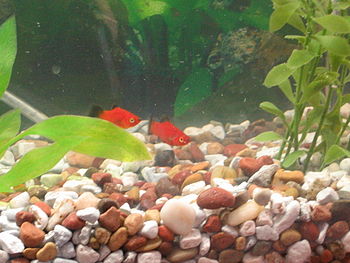 |
| A female "Golden Comet" or "Twin Bar" Platy (Xiphophorus maculatus). (Photo credit: Wikipedia) |
They come from South America, especially Mexico and Guatemala. As they carry a dark spot on their tail, they are famous with the name 'Moonfish'.
Originally, there were two main species of platyfish. Now there are numerous varieties created by the breeders. They are interbred with swordtails and it is now very difficult to separate them from other species. Presently they are available in all possible colors you want and even in all combinations of colors your desire. So these variations make your aquarium very lively and colorful. That is the main reason for experienced fish-keepers to go for platyfish.
A well-lit aquarium with a lot of plants is ideal for platyfish. If you add a small amount of salt in the water, they are very happy to live in. Of course, this will depend on the other species of fish you are keeping in the aquarium. There should be enough open space for them for swimming and hiding. If you provide some floating plants that will automatically provide enough hiding places for them.
One important thing to remember about the colors of platyfish is - the males will not show their colors until they are fully grown up. If you keep the temperature of the water a bit colder, their colors will brighten up.
Platyfish will eat all types of live food as well as flaked food. In addition, they will eat a lot of algae and other plants. If you provide them live or frozen brine shrimp, blood-worms or tubifex, they will be very happy. They will require some amount of proteins in their food but at the same time, they will require algae in their daily diet.
The females are bigger than the males. The females grow up to 2,5 inches while the males can grow only up to 2 inches. However, the females are in plain color while males are found in a number of colors.
They can happily live in the water having a ph level of 7.0 to 8.0. The temperature of the water should be kept in the range of 60 to 75° F.
They are very easy breeders because they will reproduce without any efforts or attention on your part. They will not eat their eggs or fry and they will live peacefully with their kids. They will get overpopulated soon; you should provide enough space in your aquarium for their growth.
As they are hardy and they can tolerate a wide range of conditions of water, they make an excellent choice for both the beginners as well as for the experienced fish-keepers.
Article Source: EzineArticles |


